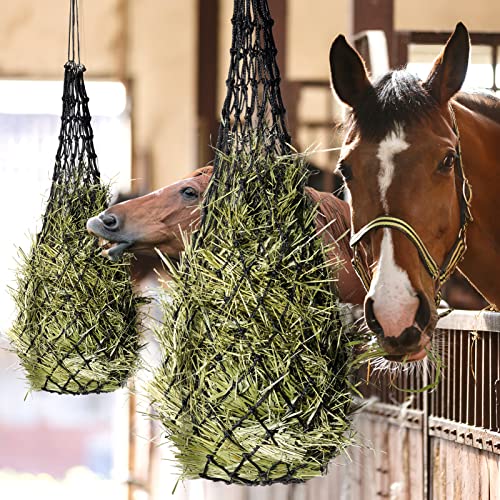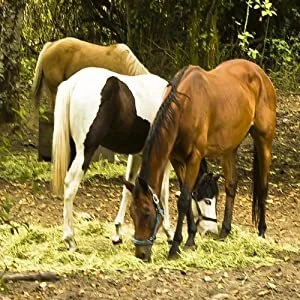Feed More Forage
Don't take hay for granted. A leading feed supplier and equine nutritionist, Marlin Statema, says it could be the most critical element in your animal's diet.
"Forage is the most important part of the horse's diet. That's because the horse evolved as a grazer. It has a very small stomach and can't take in a lot of feed at one time," says Statema, president of LMF Feeds in Deer Park, Washington.
Despite the fact that his company specializes in grain feeds, Statema encourages horse owners to make forage -- not grains -- the main part of their animals' diets.
"There's a need for grain, but people get it turned around," Statema explains. "They look at grain as the thing that keeps the horse running and hay as a filler. We say, 'No! No! No! It's the other way around.' You get most of your nutrients out of the hay and fill in the blanks with your grain and a supplement."
Statema's opinions are supported by researchers Dr. Joe Pagan and Dr. Stephen Jackson of Kentucky Equine Research in Versailles, Kentucky. Their studies show that a diet of at least 1-1.5 pounds of forage per 100 pounds of body weight per day greatly reduces the incidence of colic in most horses.
"In terms of colic and other digestive problems, a lot of it is tied to the lack of hind gut fermentation," Statema points out. "And that's due to not enough soluble fiber in the diet."
As a consulting horse nutritionist, Statema was called in for an assessment of the U.S.-Canada champion in three-day eventing which failed to meet expectations at the Olympics in Barcelona, Spain. He learned that while the horse was in training in England prior to the Olympics its trainers put more starch and protein content in its diet in an attempt to get greater energy.
"They were trying to get energy from grain and not from fiber," Statema points out.
The lack of fiber caused hind gut fermentation to slow down, he speculates. Once that occurs the horse will not perform and will not put on weight.
Statema recommends limiting protein consumption to 10-12 percent of a performance horse's diet. Too much protein can drive up water requirements, drop pH levels in the blood and increase the risk of intestinal disturbances. For a 1,000-pound horse on a moderate work schedule, he suggests feeding 15-16 pounds of alfalfa hay and 5-6 pounds of grain, or 16-18 pounds of grass hay with 6-7 pounds of grain.
As work intensity increases the amount of grain and minerals in the diet must increase as well, but protein percentages should remain much the same. LMF produces feed grains formulated for specific levels of performance and hay feed types which help balance the horse's diet.
In gestating mares receiving alfalfa hay, Statema recommends a low protein (10-12 percent) grain that's low in calcium and high in phosphorous, copper, zinc, selenium and vitamin E. Those being fed grass hay need higher protein (12-14 percent) grain, and relatively high levels of calcium, phosphorous, selenium, and vitamin E.
"Seventy percent of fetal growth takes place in the last three months of pregnancy," Statema points out. Consequently, the mare's need for protein, minerals and vitamins increases significantly. Hay consumption should rise to 1.5 - 2 percent of body weight daily with grain consumption at .5-1 percent.
Weanlings can be fed alfalfa or grass hay with protein levels of 12-14 percent for the first year. With alfalfa, feed 1.5-2 pounds of forage per 100 pounds of weight and 1 pound of grains per 100 pounds. Grains should be low in protein, high in energy, low in calcium and high in phosphorous.
If grass hay is fed to weanlings, Statema recommends a similar ratio of forage but a slightly higher ratio (1-1.25) of grain. The grain mix should have relatively high protein (15-16 percent).
Beyond 18 months of age, the horse's feed should be determined by the activity level of the horse rather than on its rate of growth. For mature horses on limited exercise, Statema suggests a daily grain ration of .3 pounds per 100 pounds of body weight and about a half-pound of hay per 100 pounds of body weight. The grain mix is formulated for the type of hay being used.
Buying good quality hay, however, is a problem. The trouble with alfalfa hay, according to Statema and other equine nutritionists, is that most of it is grown for the dairy market and is consequently rich in protein and lacking in fiber. This can be a problem in performance horses especially, causing ammonia buildup from the excess protein.
"What horses are often getting is dairy hay," Statema points out. "That's because most growers are aiming for the dairy market."
Grass hay needs to be cut early in its development in order to provide the fermentable fiber with low lignin content that horses require.




